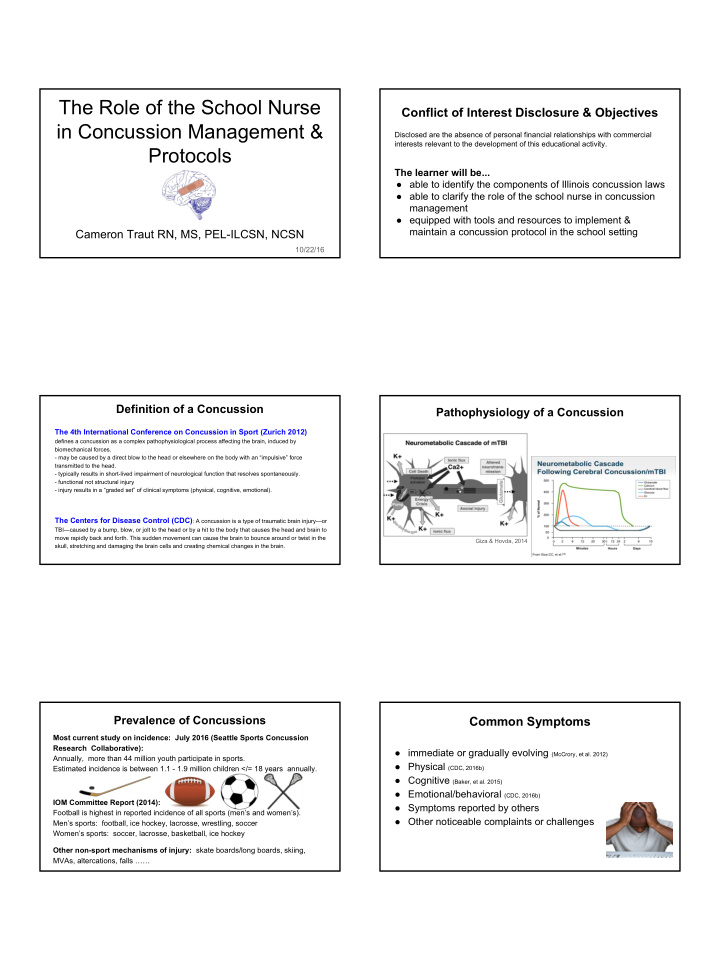



The Role of the School Nurse Conflict of Interest Disclosure & Objectives in Concussion Management & Disclosed are the absence of personal financial relationships with commercial interests relevant to the development of this educational activity. Protocols The learner will be... ● able to identify the components of Illinois concussion laws ● able to clarify the role of the school nurse in concussion management ● equipped with tools and resources to implement & maintain a concussion protocol in the school setting Cameron Traut RN, MS, PEL-ILCSN, NCSN 10/22/16 Definition of a Concussion Pathophysiology of a Concussion The 4th International Conference on Concussion in Sport (Zurich 2012) defines a concussion as a complex pathophysiological process affecting the brain, induced by biomechanical forces. - may be caused by a direct blow to the head or elsewhere on the body with an “impulsive” force transmitted to the head. - typically results in short-lived impairment of neurological function that resolves spontaneously. - functional not structural injury - injury results in a “graded set” of clinical symptoms (physical, cognitive, emotional). The Centers for Disease Control (CDC) : A concussion is a type of traumatic brain injury—or TBI—caused by a bump, blow, or jolt to the head or by a hit to the body that causes the head and brain to move rapidly back and forth. This sudden movement can cause the brain to bounce around or twist in the Giza & Hovda, 2014 skull, stretching and damaging the brain cells and creating chemical changes in the brain. Prevalence of Concussions Common Symptoms Most current study on incidence: July 2016 (Seattle Sports Concussion Research Collaborative): ● immediate or gradually evolving (McCrory, et al. 2012) Annually, more than 44 million youth participate in sports. ● Physical (CDC, 2016b) Estimated incidence is between 1.1 - 1.9 million children </= 18 years annually. ● Cognitive (Baker, et al. 2015) ● Emotional/behavioral (CDC, 2016b) IOM Committee Report (2014): ● Symptoms reported by others Football is highest in reported incidence of all sports (men’s and women’s). ● Other noticeable complaints or challenges Men’s sports: football, ice hockey, lacrosse, wrestling, soccer Women’s sports: soccer, lacrosse, basketball, ice hockey Other non-sport mechanisms of injury: skate boards/long boards, skiing, MVAs, altercations, falls ……
Duration of symptoms Illinois Laws 1-3 weeks = typical adolescent recovery (50%) 3-6 weeks = 40% 2-3 months = 6% P.A. 097-0204 Protecting our Student Athletes Act (2011) > 3 months = 4% (McAvoy, 2012) P.A. 098-1011 Amendment to The Interscholastic Athletic Organization Act (2014) Children younger than 13 years old appear to recover more quickly than adolescents. (Purcell, et al. 2015) P.A. 099-0245 Youth Sports Concussion Safety Act (2015) Recovery of symptoms can vary at different rates. (Sady, et al. 2011) P.A. 99-0831 Amendment to The Interscholastic Athletic Organization Act (2016) Premorbid conditions - ADHD, mental health diagnoses, learning disabilities, hx of concussions or migraines……. (Illinois General Assembly, 2016) (Sady, et al. 2011) Role of the School Nurse: Team Leader Role of the School Nurse: Coordinator of Care (Ladd, 2009) Multidisciplinary Care Team: Concussion Oversight Team: School Nurse Parent School Nurse Athletic Trainer School Psychologist Athletic Trainer Student School Counselor Athletic Director Teachers Primary Physician Physician PE Teacher Coaches Physician Specialist Teachers Coach School Counselor School Psychologist Administrators School Social Worker School Social Worker Parent Special Education Representative (NASN, 2016a) Role of the School Nurse: Team Leader General Recommendations for Accommodations (Denehy, 2008) - Rest breaks during day PRN ● LEADER - Reduced class schedule for a short time ● Identifying the issues - Limit “screen time” ● Data - “Mastery of skills/concepts” ● Know the laws - Extra time/extend deadlines ● Policy vs. Protocol - what’s the difference? http://researchguides.ebling.library.wisc.edu/c.php?g=293229&p=1953402 - No assessments/limit testing/portions - Visual: Printed notes, enlarged print, colored paper, audio books, sun Protocol: An agreed framework outlining the care that will be provided to patients in a designated glasses, hats area of practice. They do not describe how a procedure is performed, but why, where, when and by whom the care is given.(University of Wisconsin-Madison, Health Sciences, 2016) - Leave classes early to avoid congested halls Policy: A formal written statement detailing the particular action to be taken in a particular situation that (Lurie Children’s Hospital, 2015) is contractually binding. (University of Wisconsin-Madison, Health Sciences, 2016)
Concussion Protocol for Schools - An example Role of the School Nurse: Advocate When symptoms extend beyond the average 2-3 weeks……. Accommodations or Modifications? Concussion specialist Accommodations at school become more complex - Adjusting school day - Tutoring Support Libertyville High School - Classwork: essential and mastery - Changing course levels - 504 plan Accommodations may become modifications = IEP Neuropsych testing (Sady, et al. 2011) Role of the School Nurse: Prevention Role of the School Nurse: Gatekeeper / Advocate (NASN, 2016b) Concussion management in a school setting is a complex issue. (Traut & Dube, 2016) Data Collection Duty of Safe Care (Schoepfer-Bochicchio & Dodds, 2015) Elementary schools Examples of issues that may arise….. High Schools ● PE/recess participation without formal RTP in place in these areas. ○ Does the nurse manage RTP? Give recommendations to PE teacher? Have student report to Access to healthcare nurse after PE every day? Send student to AT? ○ How is return to recess handled? ● Club or private sports organizations outside of school. Culture change/attitude shift ○ Student begins RTP with club sport while not cleared by physician for school RTL. ● Physician recommendations are not in alignment with current best practices for concussion management or school protocol. (Ladd, 2009) Role of the School Nurse: Evaluator Decision-Making Checklist (Traut & Dube, 2016) (NASN, 2016) ● Always be open to feedback from team members ● Review process within each student’s experience ● Reconvene concussion oversight committee regularly (at least annually) ● Review protocol for updates and changes …
Recommend
More recommend